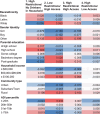Parents' perspectives and behaviors regarding their child's access to alcohol: Variation by race/ethnicity, socioeconomic status, and neighborhood
- PMID: 39701594
- PMCID: PMC11740169
- DOI: 10.1111/acer.15498
Parents' perspectives and behaviors regarding their child's access to alcohol: Variation by race/ethnicity, socioeconomic status, and neighborhood
Abstract
Background: Setting rules about alcohol use and minimizing its availability in the home are known effective parent-level strategies for reducing underage drinking risk. However, parents' restrictions and their perceptions of their child's alcohol access have rarely been considered in combination (e.g., determining if rule-setting consistently accompanies perceived easy access), despite the potential to inform targeted prevention. The current study identified patterns in six parent-reported indicators of their child's alcohol restrictions and access and characterized them with respect to race/ethnicity, socioeconomic status, community type (urban, suburban, or rural), and neighborhood (dis)advantage.
Methods: Latent profile analysis was applied to Follow-up Year 2 data from the parents of Black, Latinx, and White participants in the Adolescent Brain Cognitive Development Study (n = 9586; youth mean age = 12.05; 47.50% girl, 51.32% boy, 0.32% other gender; 14.29% Black, 25.97% Latinx, and 59.74% White) to derive distinct profiles.
Results: Four profiles (subgroups) emerged: High Restrictions/No Drinkers in Household (32.18%), Low Restrictions/High Access (29.58%), High Restrictions/High Access (26.38%), and High Restrictions/Low Access (11.86%). Black and Latinx youth and parents with relatively low educational attainment and income were overrepresented in the High Restrictions/No Drinkers in Household and High Restrictions/Low Access subgroups. By contrast, the low restrictions subgroups were composed primarily of parents of White youth living in advantaged neighborhoods.
Conclusions: Findings support the notion that parents' perspectives and behaviors around youth alcohol access cannot be divided simply into restrictive and permissive. Further, the observed differences by demographic and neighborhood factors suggest the value of tailoring parent-level prevention approaches to consider community norms.
Keywords: alcohol access; parental rules; race/ethnicity; socioeconomic status; youth.
© 2024 The Author(s). Alcohol, Clinical and Experimental Research published by Wiley Periodicals LLC on behalf of Research Society on Alcohol.
Conflict of interest statement
The authors have no conflict of interest to declare.
Figures


Similar articles
-
Factors that influence parents' and informal caregivers' views and practices regarding routine childhood vaccination: a qualitative evidence synthesis.Cochrane Database Syst Rev. 2021 Oct 27;10(10):CD013265. doi: 10.1002/14651858.CD013265.pub2. Cochrane Database Syst Rev. 2021. PMID: 34706066 Free PMC article.
-
Parents' and informal caregivers' views and experiences of communication about routine childhood vaccination: a synthesis of qualitative evidence.Cochrane Database Syst Rev. 2017 Feb 7;2(2):CD011787. doi: 10.1002/14651858.CD011787.pub2. Cochrane Database Syst Rev. 2017. PMID: 28169420 Free PMC article.
-
Face-to-face interventions for informing or educating parents about early childhood vaccination.Cochrane Database Syst Rev. 2018 May 8;5(5):CD010038. doi: 10.1002/14651858.CD010038.pub3. Cochrane Database Syst Rev. 2018. PMID: 29736980 Free PMC article.
-
Interventions to improve access to cataract surgical services and their impact on equity in low- and middle-income countries.Cochrane Database Syst Rev. 2017 Nov 9;11(11):CD011307. doi: 10.1002/14651858.CD011307.pub2. Cochrane Database Syst Rev. 2017. PMID: 29119547 Free PMC article.
-
The association of witnessing violence with alcohol and cannabis expectancies among Black, Latinx, and White youth: considering neighborhood context.Soc Psychiatry Psychiatr Epidemiol. 2025 Jul 2. doi: 10.1007/s00127-025-02939-8. Online ahead of print. Soc Psychiatry Psychiatr Epidemiol. 2025. PMID: 40603722
References
-
- Arthur, M.W. , Briney, J.S. , Hawkins, J.D. , Abbott, R.D. , Brooke‐Weiss, B.L. & Catalano, R.F. (2007) Measuring risk and protection in communities using the communities that care youth survey. Evaluation and Program Planning, 30(2), 197–211. Available from: 10.1016/j.evalprogplan.2007.01.009 - DOI - PubMed
-
- Bakk, Z. , Oberski, D.L. & Vermunt, J.K. (2016) Relating latent class membership to continuous distal outcomes: improving the LTB approach and a modified three‐step implementation. Structural Equation Modeling, 23(2), 278–289. Available from: 10.1080/10705511.2015.1049698 - DOI
-
- Bakk, Z. & Vermunt, J.K. (2016) Robustness of stepwise latent class modeling with continuous distal outcomes. Structural Equation Modeling: A Multidisciplinary Journal, 23(1), 20–31. Available from: 10.1080/10705511.2014.955104 - DOI
-
- Benjamini, Y. & Hochberg, Y. (1995) Controlling the false discovery rate: a practical and powerful approach to multiple testing. Journal of the Royal Statistical Society: Series B, 57(1), 289–300.
Grants and funding
- U24 DA041147/DA/NIDA NIH HHS/United States
- U01 DA051039/DA/NIDA NIH HHS/United States
- U01 DA041120/DA/NIDA NIH HHS/United States
- R00AA025394/AA/NIAAA NIH HHS/United States
- U01 DA051018/DA/NIDA NIH HHS/United States
- U01 DA041093/DA/NIDA NIH HHS/United States
- R01 MD016922/MD/NIMHD NIH HHS/United States
- R01MD016922/MD/NIMHD NIH HHS/United States
- U24 DA041123/DA/NIDA NIH HHS/United States
- U01 DA051038/DA/NIDA NIH HHS/United States
- P60AA006282/AA/NIAAA NIH HHS/United States
- U01 DA051037/DA/NIDA NIH HHS/United States
- U01 DA051016/DA/NIDA NIH HHS/United States
- U01 DA041106/DA/NIDA NIH HHS/United States
- U01 DA041117/DA/NIDA NIH HHS/United States
- U01 DA041148/DA/NIDA NIH HHS/United States
- U01 DA041134/DA/NIDA NIH HHS/United States
- U01 DA041022/DA/NIDA NIH HHS/United States
- U01 DA041156/DA/NIDA NIH HHS/United States
- U01 DA050987/DA/NIDA NIH HHS/United States
- U01 DA041025/DA/NIDA NIH HHS/United States
- U01 DA050989/DA/NIDA NIH HHS/United States
- U01 DA041089/DA/NIDA NIH HHS/United States
- U01 DA050988/DA/NIDA NIH HHS/United States
- U01 DA041028/DA/NIDA NIH HHS/United States
- U01 DA041048/DA/NIDA NIH HHS/United States
- R00 AA025394/AA/NIAAA NIH HHS/United States
- U01 DA041174/DA/NIDA NIH HHS/United States
- R25 DA054015/DA/NIDA NIH HHS/United States
LinkOut - more resources
Full Text Sources

